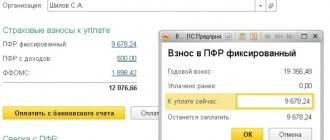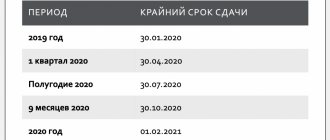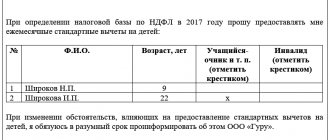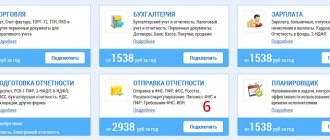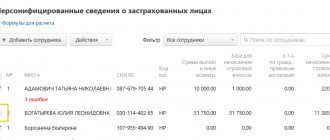Terms and procedure for provision
The deadline for submitting the calculation is the same for all employers - the form must be sent to the territorial body of the Federal Tax Service at the place of registration of the insurance premium payer no later than the 30th day of the month following the reporting period. In this case, the calculation period for contributions is a calendar year, and the reporting periods are:
- I quarter;
- half year;
- 9 months.
The deadlines for submitting the report in 2021 are as follows:
- for the first quarter of 2021 - until 05/03/2019;
- for the first half of 2021 - until July 30, 2019;
- for 9 months of 2021 - until October 30, 2019;
- for the billing period (2020) - until 01/30/2019.
Basic information ↑
RSV-1 is a very important document. Any entrepreneur or head of an organization, regardless of the type of tax regime used, should be sure to familiarize themselves with all the basic provisions and information regarding this certificate.
This will avoid many problems, as well as unnecessary attention from the Federal Tax Service. Basic information you need to know:
- definitions;
- who should take the test;
- normative base.
Definitions
All kinds of concepts and definitions relating to RSV-1 are reflected in various regulatory documents, as well as current legislation.
This abbreviation has the following definition: “calculation of accrued and paid insurance premiums.” Moreover, contributions to the following funds are taken into account:
| In compulsory medical insurance | Compulsory health insurance |
| To the Pension Fund | Russian Pension Fund |
This document displays all amounts that were allocated for the following purposes:
| Formation of the insurance part of the pension | SSP |
| Formation of the funded part of the pension | PPP |
| To the Federal Compulsory Medical Insurance Fund (compulsory medical insurance) | FFOMS |
| To territorial compulsory medical insurance funds | TFOMS |
The duration of the billing period for DAM-1 is 12 calendar months. The duration of the reporting periods is 12, 9, 6, 3 months.
In this case, this document must be submitted quarterly. All information is received on a cumulative basis from the very beginning of the calendar year.
The legislation defines the following deadlines for filing RSV-1:
| General principle | By the 15th day of the month following the reporting period |
| After the first quarter | Until May 15 |
| After 6 months | Until August 15 |
| After 9 months | Until November 15 |
| After 12 months | Until February 15 |
If the organization was created in the middle of the year, then RSV-1 is also required to be submitted to it.
This must be done after the end of the quarter in which it was registered and began to conduct commercial activities and make contributions for individuals to the relevant funds.
Who should take it?
The list of organizations, as well as persons obligated to take the RSV-1, is announced in the legislation of the Russian Federation.
Thus, this document is required to be submitted to the Pension Fund of the Russian Federation within the established time frame:
| Individual entrepreneurs | Having employees on their staff |
| Individuals | Individual entrepreneurs who are not, but have entered into an employment contract with another individual |
| Organizations | Regardless of the form of ownership |
The basis for this is Federal Law No. 212-FZ.
Normative base
The regulatory framework relating to the document in the RSV-1 form is quite extensive. It includes the following:
- Federal Law No. 333-FZ of December 2, 2013
- Decree of the Government of the Russian Federation dated November 30, 2013 - this PP determines the amount of the amount based on which insurance premiums are formed (for 2021 the amount was 624,000 rubles).
Over time, various amendments have been made to the regulatory framework. Most of them were included precisely in Federal Law No. 333 of December 2, 2013:
| Federal Law No. 212-FZ regarding insurance premiums has been amended | A reduction in tariffs is used for individual entrepreneurs and organizations using the “simplified system” |
| Amended Article No. 58.2 (Law No. 212-FZ) | The tariff rate of 22% was extended |
There is one important nuance - reduced tariffs apply only to certain types of activities and organizations:
- charitable;
- pharmacy;
- Individual entrepreneurs applying the patent taxation system.
What insurance premiums are paid to the Pension Fund of Individual Entrepreneurs, see the article: Pension Fund. What types of activities are permissible under the patent tax system in 2021, read here.
However, the reduced rate can only be used until 2020. Also, the regulatory framework regarding RSV-1 should include:
| Federal Law No. 351-FZ | Some amendments have been made to the laws - on Pension Insurance No. 163-FZ, on accounting (personalized) No. 27-FZ |
| Federal Law No. 421-FZ | Amendments were made to laws No. 212-FZ, No. 167-FZ |
Pension legislation will soon be subject to reform. The most important change that will affect everyone (individual entrepreneurs and legal entities) is that it will be necessary to submit monthly RSV-1 calculations to the Pension Fund of the Russian Federation.
The innovation is necessary to track the wages of workers by age or who have retired due to other circumstances.
In the future, the Ministry of Labor plans to refuse pension payments to working pensioners at a certain salary level.
RSV submission form
If the average number of employees of an organization for the previous reporting (calculation) period exceeds 25 people, then the policyholder can only submit an electronic DAM; paper version is not required. The accounting department knows very well what this is: you need to generate a report in a special program, certify it with an electronic signature and send it to the tax service via the Internet. A similar requirement applies to all newly created organizations with more than 25 employees. All other companies can report on paper.
We must not forget that failure to comply with the procedure for submitting the DAM form threatens the payer with a fine of 200 rubles under Article 119.1 of the Tax Code of the Russian Federation.
Filling procedure and features
When filling out DAM forms, you still need to follow certain rules. Information about them can be found both in administrative and explanatory acts of the Federal Tax Service. The current form for a single calculation for insurance premiums and the procedure for filling it out are approved by Order of the Federal Tax Service of the Russian Federation dated October 10, 2016 No. ММВ-7-11/ [email protected] KND code 1151111. Second source: letters and official explanations. The Russian Federal Tax Service constantly publishes various explanations on how to fill out this report. For example, the Letter of the Federal Tax Service of the Russian Federation dated April 12, 2017 No. BS-4-11 / [email protected] states who must fill out which section. These data are shown in the table:
| Category of employer-insurer | What you need to fill out |
| All insurers (legal entities and individual entrepreneurs, except heads of peasant farms) |
|
| Additionally, these employers must fill out if they fall into the following categories: | |
|
|
|
|
|
|
At the same time, policyholders are required to submit a “zero” DAM. In letter No. BS-4-11/4859 dated March 17, 2017, tax officials reminded that if employees were not paid wages in the reporting quarter, then subsection 3.2 of Section 3 does not need to be filled out. There are also opinions that if an organization does not make payments in favor of individuals, and therefore no insurance premiums during the billing (reporting) period, it is still obliged to provide a calculation with zero indicators. This, in particular, is stated in the Letter of the Ministry of Finance of the Russian Federation dated March 24, 2017 No. 03-15-07/17273.
Let's look at a few more important explanations about the features of filling out this form in more detail.
The procedure for filling out the RSV-1 form
Let's look at the procedure for filling out the RSV. We have already mentioned that this is a voluminous document, and it is better to entrust its completion to an experienced specialist. For example, an accountant. The report form includes a minimum of 12 pages, or rather 6 sections with subsections. Electronically presented in the form of an Excel table. How to fill out the RSV?
On the first page of the document, the employer’s data (name and TIN), the number of insured persons and the average number of employees (do not be confused with the arithmetic average) are indicated. The bottom lines indicate how many pages there are in the report and confirm the accuracy of the information provided. This is the simplest part of the document, the preparation of which does not require any special knowledge.
In RSV-1, Section 1 is devoted to general data on the obligations of the payer, that is, the author of the declaration. He indicates here the total value of insurance premiums, and also breaks down this amount by month. If recalculation for previous months is necessary, it is also done line by line at the bottom of this section. The subsections describe calculations of payments for additional tariffs, for certain categories of payers, for dangerous and harmful working conditions. Section 2 ends with a page where the author of the declaration reports on the stacks of documents submitted for previous years (up to 2010).
Appendix 1 is directly devoted to the calculation of payments to insurance funds. The author of the declaration consistently writes:
- number of insured persons;
- amounts of payments to them;
- the amount of insurance premiums.
Section 3 is devoted to confirming the right to apply a reduced tariff. Here the employer will write the amount of income for the previous 9 months and the average. If a recalculation of payments is required from the beginning of the billing period, it will be reflected in section 4. Section 5 usually remains empty, because it involves providing information about payments to students of secondary and higher educational institutions who are members of student groups. In practice, such associations are rare.
Section 6 requires the indication of information about each insured person, that is, about each employee. One person - one sheet. Therefore, section 6 will be presented in batches of sheets in the number of employees of the organization (the number of insured persons). Here you need to indicate the employee’s full name, the reporting period and, most importantly, provide information about payments in favor of this person in the form of a table. Section 6 allows a maximum of 200 sheets, but even then they are provided without an inventory.
The title page of the RSV will contain general information about the organization and confirmation of the accuracy of the information
Sample
Preparing the RSV-1 declaration requires quite a lot of time, specific knowledge and care. Over time, this form becomes easier to submit because some of the information will actually be duplicated (for example, much of the content in Section 6). However, it will be difficult to work with this document the first time in any case. To make things a little easier, try:
- involve an experienced specialist in the preparation (even an outsourced consultant will do, who will tell you what and how to write for a small fee);
- watch video tutorials;
- use special software that will check the correctness of document preparation (for example, “Contour. Accounting”).
: RSV-1
filling: RSV-1 (filling sample)
Changes to the DAM in 2021
In 2021, a new form of the DAM comes into force - the corresponding news and the draft of the new document appeared on the website of the tax service in the summer of 2021. Data in updated form will need to be submitted for the first reporting period of 2021. The changes are minor and do not affect the basic structure of the document, so all the above recommendations for filling out are relevant.
What changes in RSV-1:
- new field “payer type” (1 - made payments to individuals over the last 3 months, 2 - did not make payments to individuals over the last 3 months);
- the principle of filling in a cumulative total is canceled, instead - separate reports for the quarter;
- new fields for recording tax deduction amounts;
- The lines in subsection 2.2 are deleted. on preferential activities.
Download : RSV (project 2019)
Reflection of expenses not subject to insurance premiums
The Federal Tax Service of Russia, in Letter No. GD-4-11/ [email protected] , explained how the payer must reflect in the DAM the amount of expenses and payments in favor of employees who are not subject to contributions. Such expenses are listed in Article 422 of the Tax Code of the Russian Federation and they must be included in reporting if they are recognized as an object of contributions. And all payments that are not subject to taxation do not need to be indicated in the calculation.
As a result, the policyholder must determine the taxable base as the difference between payments accrued in favor of individuals, subject to insurance premiums, and amounts exempt from them. This is the value that needs to be entered into the report to avoid errors. An example of such payments is a child care allowance for up to 1.5 years; the employer must indicate it. Since, according to the provisions of Article 420 of the Tax Code of the Russian Federation, such a payment is subject to compulsory social insurance, but according to the provisions of Article 422 of the Tax Code of the Russian Federation, it is exempt from taxation.
Filling out the DAM by employers on UTII or simplified tax system
Organizations or individual entrepreneurs that operate under a simplified taxation system or are payers of a single tax on imputed income may also have employees, which means they are required to submit calculations on a general basis, and they are concerned about the question of how to correctly fill out the RSV certificate. 1. What are these features that simplifiers need to take into account? Tax officials spoke about this in Letter No. GD-4-11 dated December 28, 2017 / [email protected] It, in particular, says that organizations that pay contributions at the general rate and at the same time apply the simplified tax system or UTII must fill out Appendix 1 to Section 1 of the RSV indicating one payer tariff code from those listed below:
- «01»,
- «02»,
- «03»,
since they correspond to the same category code of the insured person “NR”. Tax officials also explain that all tariff codes used by payers are specified in Appendix No. 5 to the procedure for filling out the form. It is also necessary to take into account that in field 200 of section 3 it is necessary to indicate the category code of the insured person in accordance with Appendix No. 8 to the filling procedure. The tariff code and the category code of the insured person must correspond to each other.
Which government agency is responsible for debt collection?
In Russia, the enforcement of court decisions is carried out by the bailiff service (hereinafter referred to as the FSSP).
To carry out enforcement actions, it is necessary to submit to the service employees an application and a writ of execution issued in court. On the basis of such documents, the FSSP initiates enforcement proceedings. In this case, the debtor is given five days to voluntarily repay the debt. If this does not happen, the bailiffs have the right:
- seize the defendant's accounts and property;
- carry out withdrawal of funds and other securities;
- verify financial documentation;
- put the debtor and his property on the wanted list through requests to various authorities.
Considering that the bailiffs have a lot of cases pending, the collection procedure can last for years. Therefore, it is necessary to regularly remind you of your interest and in every possible way contribute to its resolution.
What is the Federal Debt Collection Service?
One of the largest organizations specializing in working with debtors who have taken out a loan and do not fulfill their obligations is the national (federal) loan collection service. Its activities differ from the work of FSSP employees; it begins with the pre-trial stage of proceedings, when the borrower can be forced to pay off the creditor.
In addition, it also takes measures at the stage of the judicial process, as compulsory methods of collection.
The main subjects from whom credit debts are collected are clients of the credit institution who borrowed money or purchased any equipment on credit. This may apply to both loans for small amounts, up to 5,000 rubles, and large debts in the amount of more than 500 thousand rubles.
Of course, the methods used to achieve the result are very different. So, for example, if there is a large amount of debt, strong pressure will be exerted, but if we are talking about purchasing inexpensive equipment with credit funds, then the methods will not be so aggressive.
How does a debt collection service work?
Communication with the debtor is made in various ways, including telephone calls, sending letters, and personal meetings with the borrower. The organization's website defines activities that are applied consistently.
So, for example, first an analysis of the debt that has arisen is carried out, the client is studied, and payments are monitored. The company’s specialists must make sure that the situation is a dead end and the debtor does not plan to repay the loan.
Then pre-trial collection can be used, in particular, informing the debtor before the court hearings.
It should be noted that the actions of collectors very often cause negative emotions. Of course, such specialists are necessary, since they resolve issues of returning borrowed funds to their original owners. After all, there is a whole category of borrowers who are dishonest about their credit obligations and are not inclined to pay off debts without the proper impact on them. And it is necessary to work with such subjects.
But the methods that private debt collectors use are often illegal. For example, in accordance with the regulatory framework governing the rules for carrying out collection measures, they can inform the debtor. But in reality, various options are used to intimidate a person and his family members.
People are bombarded with threatening letters, calling close friends, relatives, colleagues and employers during work and free time, at any time of the day. Employees of such agencies allow themselves to break into the apartments of debtors. This is completely unacceptable.
Critical errors in reporting
The Federal Tax Service accepts reporting with some types of errors, and some are considered critical, so if they were made, the tax authorities will recognize the calculation as not provided. Such errors, in the case of RSV in particular, include:
- discrepancy between the data on the total amount of insurance contributions for pension insurance and the data on the amount of calculated contributions for each insured person for the reporting period. That is, in the RSV, line 061 in columns 3–5 of Appendix 1 of Section 1 of the calculation must coincide with the data in line 240 of Section 3;
- inaccurate personal data of the insured persons (SNILS, TIN (if available) and full name).
In addition, critical errors include incorrectly specified information in section 3 by line:
- 210 - the amount of payments and other remuneration for each of the last three months of the reporting or billing period;
- 220 - the base for calculating pension contributions within the limit for the same months;
- 240 - the amount of calculated pension contributions within the limit for the same months;
- 250 - totals for columns 210, 220 and 240;
- 280 - the base for calculating pension contributions at the additional tariff for each of the last three months of the reporting or billing period;
- 290 - the amount of calculated pension contributions at the additional tariff for the same months;
- 300 - totals for columns 280, 290.
Such errors can be corrected by submitting a new calculation with the correct data within the established time frame. Otherwise you will have to pay a fine.
Responsibility for late submission and errors
If an organization or individual entrepreneur untimely sends the DAM to the Federal Tax Service, it faces a fine under Article 119 of the Tax Code of the Russian Federation. Its amount is 5% of the amount of insurance premiums not paid on time based on the data provided by the calculation. The maximum penalty is 30% of the amount of contributions. If there is no underpayment, the employer who is late with reporting will still be fined 1,000 rubles. In addition, if the payment is not provided within 10 days after the due date, in accordance with the new edition of Article 76 of the Tax Code of the Russian Federation, tax authorities have the right to block transactions on the bank account of the paying organization.
Also responsible in this case will be the officials of the insured organization, as a rule, the director. According to the provisions of Article 15.5 of the Code of Administrative Offenses of the Russian Federation, in this case, a warning or an administrative fine in the amount of 300 to 500 rubles is provided.
Legal documents
- Article 119.1 of the Tax Code of the Russian Federation
- By order of the Federal Tax Service of the Russian Federation dated October 10, 2016 No. ММВ-7-11/ [email protected]
- Letter dated 08/08/2017 No. GD-4-11/ [email protected]
- Article 422 of the Tax Code of the Russian Federation
- Article 420 of the Tax Code of the Russian Federation
- Article 119 of the Tax Code of the Russian Federation
- Article 76 of the Tax Code of the Russian Federation
- Article 15.5 of the Code of Administrative Offenses of the Russian Federation
What kind of company is this and what does it do?
In fact, behind six incomprehensible letters lies a definition that is quite ordinary for the modern world. The organization “RSV LLC” is a limited liability company “Regional Collection Service”, to describe them simply - a collection agency.
The general director of the organization is Kreditexpress Finance, which acts as a management company. Judging by the legal address, the organization is located in Moscow at the address: Butyrsky Val Street, building 68/70 and occupies several premises (clarifications can be attached in the letter, there is no exact information).
- The organization's hot phone number is 8-800-775 76 23 (additional 8-499-750 15 76). However, if something happens, the employees themselves will call you, and then we will explain why.
- Email, and the official website is rsvcollection.ru.
Collection agencies have long been associated by ordinary people with huge thugs who have no pity or compassion - in most cases, this characteristic coincides with the real state of affairs.
According to the legislation of the Russian Federation, such organizations have the right to communicate with the debtor through notices (letters by mail), calls and personal meetings. The above actions can be carried out from 8 am to 10 pm, except weekends and holidays.
The organization “RSV LLC” is a collection agency
In simple words, the agency is engaged in collecting debts, although the majority of those receiving such “chain letters” are more likely to be aware of the situation. The above-mentioned “framework of oppression” is provided for review and presentation in case of violation - roughly speaking, you may not answer calls or knock on doors if they call you or come to your doorstep at night.
If you think that you are being persecuted unfairly, or that RSV LLC begins to go beyond what is permitted, seek advice from lawyers or the police.
